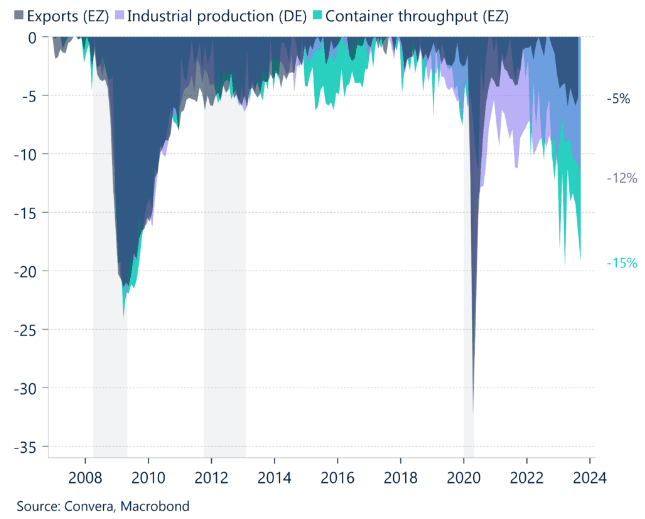Euro-Dollar Rally Stalls As "Germany's Macro Horror Show Continues"
- Written by: Gary Howes
-

Image © Thorsten Schier, Adobe Images
The Euro to Dollar exchange rate's rally has stalled at 1.0750 amidst fears the U.S. Federal Reserve will push back against a recent loosening in financial conditions and as Germany prints another disappointing set of industrial numbers.
German industrial production shrank 1.4% month-on-month in September, which was below the -0.1% expected by the market and represents an accelerated decline on August's -0.1% reading.
Destatis said the deterioriation was lead by a decline in production in energy-intensive industrial branches, which fell 0.4% in September 2023 from August 2023.
"Germany’s macro horror show continues, and we are almost getting to the point where kids ask their parents where they were the last time Germany produced a series of positive macro data," says Carsten Brzeski, Global Head of Macro at ING Bank.
ING says this disappointing data release not only suggests that third-quarter GDP growth could be revised downwards, but also that the country is likely to end the year in a technical recession.
The data is at least partly contributing to a softer day for the Euro which rose sharply against then Dollar last week following Friday's unexpectedly soft U.S. labour market report.
Euro-dollar peaked at 1.0750 on Monday but has today slid below 1.07 to quote at 1.0690.
"After crossing the $1.07 mark for the first time since mid-September last week, the euro rally has stalled amid a slight rebound in US yields and a continued stream of euro negative data," says Ruta Prieskienyte, FX Strategist at Convera.
The German industrial production data is just the latest release to confirm the Eurozone's economy remains in a precarious position, with Eurozone PMI data for October signalling a potential contraction during the month.
"As the evidence remains depressed at the start of Q4, risks for the euro remain skewed to the downside. While we are looking for signs for the bottoming of Eurozone, last week’s rebound in Ifo business climate survey and yesterday’s upside surprise in the German new orders are not enough to establish a narrative shift," says Prieskienyte.
Above: "Europe is feeling the global trade slowdown" - Convera. Chart shows European trade indicators, drawdown from peak.
'Peak pessimism' with regards to the Eurozone has been around for some time now and is well understood by the markets. This leaves a great deal of emphasis on the U.S. side of the equation and all eyes are on Federal Reserve speakers over the coming days where some push back against recent developments can be expected.
The below-expectation U.S. labour market report of last Friday prompted markets to raise bets the Fed has now completed its rate hiking cycle and that interest rate cuts can come forward.
This lowered the yield of U.S. bonds, which in turn brings down the cost of money in the economy, triggering an easing in financial conditions that the Fed might feel runs contrary to its agenda of bringing inflation lower.
"At issue will be whether the Fed chooses to push back against the loosening of US financial conditions," says Chris Turner, Head of FX Research at ING. "Now that these financial conditions have fully reversed that October spike, the Fed will presumably want to re-emphasise the risk of further rate hikes."
Fed speakers can push back against this development in a number of speeches scheduled for this week, and if they are successful, this can support the Dollar and further undermine EURUSD's relief rally.
"Risks look skewed to a mildly stronger dollar today," says Turner. "In the end, EUR/USD did not even get to test resistance at 1.0765 before falling back. 1.0650 seems the risk today given the event risk of hawkish Fed speakers."












